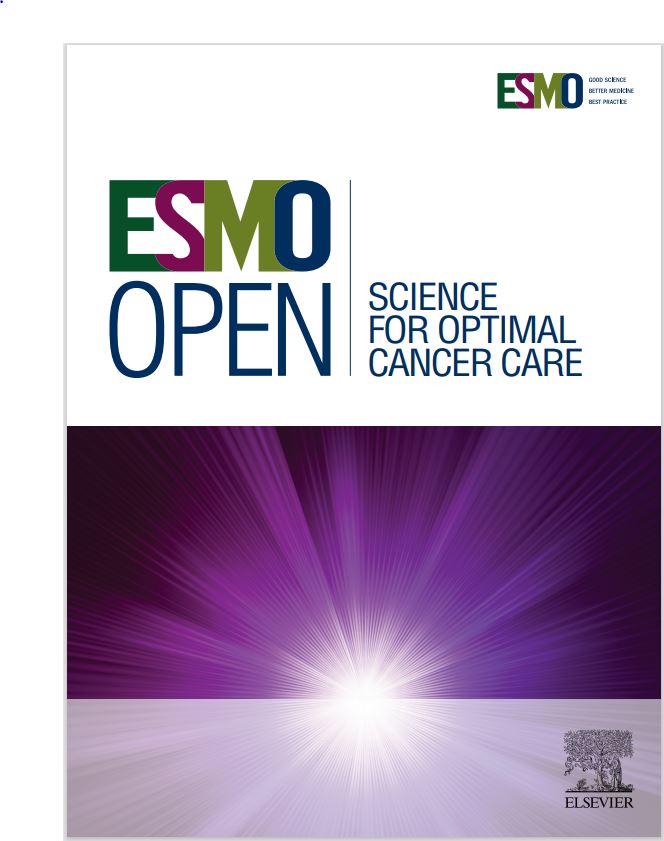Adverse events associated with sequential immune checkpoint inhibitor and alectinib in patients with ALK-rearranged advanced non-small-cell lung cancer
IF 8.3
2区 医学
Q1 ONCOLOGY
引用次数: 0
Abstract
Background
ALK tyrosine kinase inhibitors (TKIs) are the standard first-line therapy for ALK-rearranged [ALK fusion-positive (ALK+)] advanced non-small-cell lung cancer (NSCLC). In real-world practice, patients may receive immune checkpoint inhibitors (ICIs) before initiating ALK TKIs. We aimed to assess the frequency of treatment-related adverse events (TRAEs) associated with this sequential approach.
Patients and methods
We retrospectively analyzed alectinib-associated TRAEs in patients with advanced ALK+ NSCLC who received alectinib as their first TKI, with or without prior ICI exposure.
Results
We identified 166 patients, of whom 12 had prior ICI exposure. From alectinib initiation, the 12-month cumulative incidence in patients with versus without prior ICI was as follows: all-grade pneumonitis, 25.0% versus 4.6%; transaminase elevation, 25.0% versus 14.4%; and rash, 43.3% versus 5.9%. Competing-risks regression detected a higher risk of all-grade pneumonitis [hazard ratio (HR) 5.2], all-grade rash (HR 7.8), and grade ≥3 rash (HR 8.9) in patients with versus without prior ICI. Alectinib required discontinuation or hospitalization for TRAEs in 25.0% and 16.7% of patients with prior ICI, respectively, compared with 7.8% and 3.2% of patients without prior ICI.
Conclusions
Alectinib after ICI was associated with higher risks of pneumonitis and rash, and numerically higher risk of grade ≥3 hepatotoxicity, leading to increased rates of alectinib interruption and steroid use. These findings underscore the importance of expedited genotyping to guide treatment selection and avoid unwarranted ICI exposure.
序贯免疫检查点抑制剂和阿勒替尼在alk重排晚期非小细胞肺癌患者中的不良事件
背景:ALK酪氨酸激酶抑制剂(TKIs)是ALK重排[ALK融合阳性(ALK+)]晚期非小细胞肺癌(NSCLC)的标准一线治疗药物。在现实世界的实践中,患者可能在启动ALK TKIs之前接受免疫检查点抑制剂(ICIs)。我们的目的是评估与这种顺序方法相关的治疗相关不良事件(TRAEs)的频率。患者和方法:我们回顾性分析了首次接受阿勒替尼作为TKI的晚期ALK+ NSCLC患者中与阿勒替尼相关的trae,无论是否有ICI暴露。结果:我们确定了166例患者,其中12例有ICI暴露史。从阿勒替尼开始,有和没有既往ICI的患者12个月累积发病率如下:全级别肺炎,25.0%对4.6%;转氨酶升高,25.0% vs 14.4%;皮疹,43.3%对5.9%。竞争风险回归发现,与没有ICI的患者相比,有ICI的患者发生全级别肺炎(风险比(HR) 5.2)、全级别皮疹(HR 7.8)和≥3级皮疹(HR 8.9)的风险更高。有既往ICI的患者中,分别有25.0%和16.7%的患者需要停药或住院治疗trae,而没有既往ICI的患者中,这一比例分别为7.8%和3.2%。结论:ICI后阿勒替尼与肺炎和皮疹的高风险相关,并且在数值上与≥3级肝毒性的高风险相关,导致阿勒替尼中断和类固醇使用的发生率增加。这些发现强调了加速基因分型对指导治疗选择和避免不必要的ICI暴露的重要性。
本文章由计算机程序翻译,如有差异,请以英文原文为准。
求助全文
约1分钟内获得全文
求助全文
来源期刊

ESMO Open
Medicine-Oncology
CiteScore
11.70
自引率
2.70%
发文量
255
审稿时长
10 weeks
期刊介绍:
ESMO Open is the online-only, open access journal of the European Society for Medical Oncology (ESMO). It is a peer-reviewed publication dedicated to sharing high-quality medical research and educational materials from various fields of oncology. The journal specifically focuses on showcasing innovative clinical and translational cancer research.
ESMO Open aims to publish a wide range of research articles covering all aspects of oncology, including experimental studies, translational research, diagnostic advancements, and therapeutic approaches. The content of the journal includes original research articles, insightful reviews, thought-provoking editorials, and correspondence. Moreover, the journal warmly welcomes the submission of phase I trials and meta-analyses. It also showcases reviews from significant ESMO conferences and meetings, as well as publishes important position statements on behalf of ESMO.
Overall, ESMO Open offers a platform for scientists, clinicians, and researchers in the field of oncology to share their valuable insights and contribute to advancing the understanding and treatment of cancer. The journal serves as a source of up-to-date information and fosters collaboration within the oncology community.
 求助内容:
求助内容: 应助结果提醒方式:
应助结果提醒方式:


